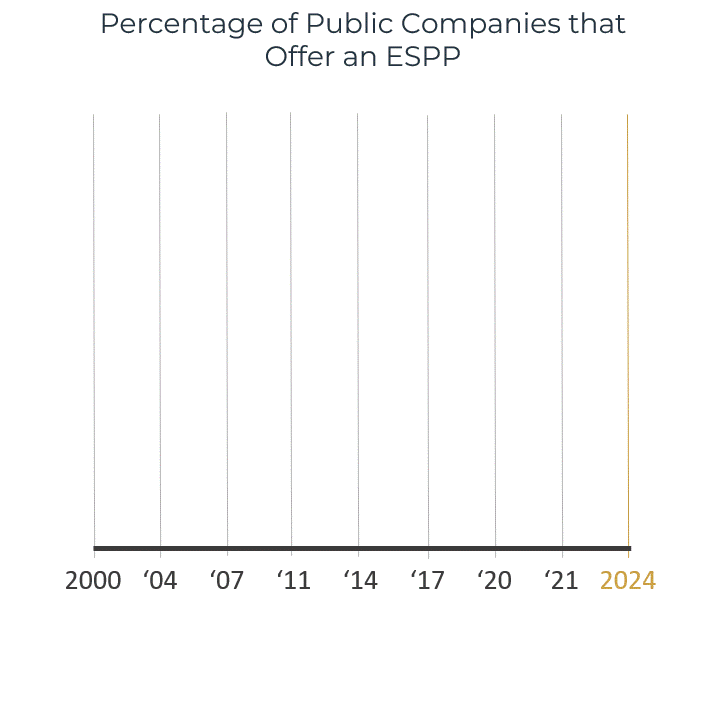
Trends in ESPPs: Five Facts and a Myth
February 05, 2025
Spoiler alert: ESPPs are growing in both prevalence and generosity, but participation rates are still disappointing. In today’s blog entry, I discuss these and other ESPP trends.
For more on ESPP trends, check out the NASPP webinar “2023 Results: Top ESPP Trends.”
Fact 1: ESPPs Are on the Rise
From 2011 to 2021, the prevalence of ESPPs remained flat, at about half of public companies. However, I’m excited to report that in the most recent NASPP/Deloitte Tax Equity Incentives Design Survey, the percentage of public companies offering an ESPP ticked up to 57%. That’s fantastic news for those of us who are big fans of ESPPs. I’m so excited, I made a GIF of the data to celebrate.

You’ll notice in my super-cool GIF that ESPPs still haven’t achieved their pre-ASC 718 zenith, but at least the trend is moving in an upward direction. Hopefully this trend will continue; maybe one day ESPPs will be as popular among public companies as RSUs, or even 401(k) plans. A gal can dream…
ESPPs are most common among technology companies (73% offer an ESPP) and among financial/insurance companies (58% offer an ESPP). The highest prevalence of ESPPs is in Silicon Valley, with nearly 80% of companies headquartered in this region offering a plan.
Fact 2: Tax-Qualified Plans Are the Standard for US Companies
Among US-headquartered companies that offer an ESPP, 84% offer a Section 423-qualified plan. This is about the same percentage as in the 2020 edition of the survey (82%).
I am a fan of nonqualified ESPPs. For one thing, I think the tax benefits are overrated. But more important, I think nonqualified ESPPs offer companies the flexibility to design a plan that will be more compelling to employees and doesn’t inherently favor their US workforce. And that’s not all—I have ten reasons you should consider a nonqualified ESPP.
Fact 3: Companies Are Offering More Generous ESPPs
We saw a notable increase in the economic benefits offered under ESPPs in the NASPP/Deloitte Tax 2023 ESPP Survey, particularly among qualified plans. When it comes to determining the purchase, among companies that offer a qualified ESPP:
- 85% offer a 15% discount, up from 70% in the 2020 survey.
- 83% offer a lookback, up from just 62% in 2020
We also saw a shift away from three-month offerings in qualified plans (16% of respondents in 2023, down from 25% in 2020) towards six-month offerings (57% in 2023, up from 49% in 2020) and 24-month offerings (13% in 2023, up from 8% in 2020)
Fact 4: Cadillac ESPPs Are a West-Coast Phenomenon
A “Cadillac” ESPP is a tax-qualified plan the features a 15% discount, lookback, and 24-month offering with purchases every three or six months. These plans deliver virtually the maximum benefit possible for a Section 423 qualified plan.
Among survey respondents that offer Cadillac ESPPs, 86% are technology companies and over 90% are headquartered on the west coast of the United States. These plans are rarely found in other regions of the country.
But this doesn’t mean other regions of the country are stingy on ESPP benefits. For example, we found the following trends among companies headquartered on the east coast:
- Fully 80% offer a tax-qualified ESPP.
- Nearly 80% of tax-qualified ESPPs offer a 15% discount.
- Over 70% of tax-qualified ESPPs offer a lookback.
East-coast companies are more likely to have a plan with a three- or six-month offering than longer offering periods. And sure, a 15% discount and lookback over a three or six month period is no “Cadillac,” but it’s still a fantastic benefit. I don’t know any other investment that offers an almost guaranteed 17.6% return or more over a three or six month period with the same risk profile as an ESPP. Even with today’s relatively high interest rates, employees sure aren’t making that on their savings accounts (not even on high-yield accounts).
Fact 5: Participation Rates Are Disappointing ☹
Given the fantastic benefit that most ESPPs offer, you’d expect participation rates to also be fantastic. Alas, the median participation rate reported by respondents to the 2023 survey is just 38%. However, we have found some segments where participation rates are higher:
- Qualified ESPPs that offer a 15% discount have a median participation rate of 48%.
- Companies with 5,000 or fewer employees report a median participation rate of 45%.
- Technology companies report a median participation rate of 48%.
West-coast companies report a median participation rate of just over 50%, whereas east-coast companies report a median participation rate of just under 30%. There could be a number of reasons for this regional difference, including the more generous plans offered by some west-coast companies. Another factor might be that, due to the prevalence of ESPPs on the west coast, employees at these companies are more likely to be familiar with these plans.
We Pause Now for Me to Get Out My Soapbox
I’m often asked how companies can increase ESPP participation. In my opinion, there are two ingredients to a high ESPP participation rate. First, the plan must be designed to encourage participation and must offer an economic benefit that is sufficient to mitigate the risk of investing in a single stock.
It is important to remember that ESPPs are a broad-based plan and that many employees who are eligible to participate in the plan probably live paycheck-to-paycheck at least occasionally. According to recent research from Bank of America, nearly half of households reported in Q3 2024 that they live paycheck-to-paycheck. [Using financial data, Bank of America estimates that the number of households who truly live paycheck-to-paycheck is lower, around 25 to 30%, but when it comes to employees agreeing to have funds withheld from their paychecks, their perception is what is most important.]
In addition, concentrated investments, like a single company’s stock (especially if that company is also your employer), are risky. Most employees tend to be risk averse and inherently understand this risk.
To encourage participation, the plan must be generous enough to mitigate the investment risk of participating for your eligible employee population. I recommend at least a 10% discount and no restrictions (holding periods, prohibition on withdrawals, etc.) that significantly increase risk. Offering cashless participation, fractional share purchases, and other features that can make it easier for lower paid employees to participate can also increase participation. See my blog on four ways to make your ESPP more equitable.
Another key feature that can encourage participation is offering a match instead of a discount. The concept of a discount can be difficult to understand, especially for employees who aren’t experienced investors. But, thanks to 401(k) plans, most people understand the value of a contribution match. The catch is that it isn’t clear that you can offer a match in a tax-qualified ESPP. Watch my video “ESPP Design: Match vs. Discount” for more thoughts on contribution matches.
Second, you have to promote the plan to employees. You must have a robust educational program with multiple touch points that explains the plan to employees and encourages them to participate. Employees will not participate if they don’t understand the plan or, worse, don’t know about it.
These two ingredients—plan design and education—are both critical. No matter how innovative an education program is, it cannot fix poor plan design. Likewise, ESPPs aren’t baseball fields in Iowa. Just because you build it, doesn’t mean they’ll come (apologies to W.P. Kinsella). You can have the El Dorado of Cadillac ESPPs (to mix my metaphors), but employees won’t participate if you haven’t effectively communicated the benefits of participation to them.
Thanks for indulging me; back to our regularly scheduled programming.
The Myth: Employees Flip ESPP Shares
A criticism I frequently hear about ESPPs is that employees “flip the shares,” meaning that they sell the shares they acquire under the plan almost immediately after each purchase. But nothing could be further from the truth. Two-thirds of companies that offer qualified ESPPs report that participants hold the stock acquired under their plan for an average of one year or longer.
At the same time, only 10% of companies that offer a qualified ESPP impose a mandatory holding period. Thus, in most cases, employees are voluntarily holding the shares they acquire under the plan.
More Information
Have I piqued your interest in ESPP trends? For more trends from the NASPP/Deloitte Tax 2023 ESPP Survey, watch the NASPP webinar “2023 Results: Top ESPP Trends.”
-

By Barbara BaksaExecutive Director
NASPP
